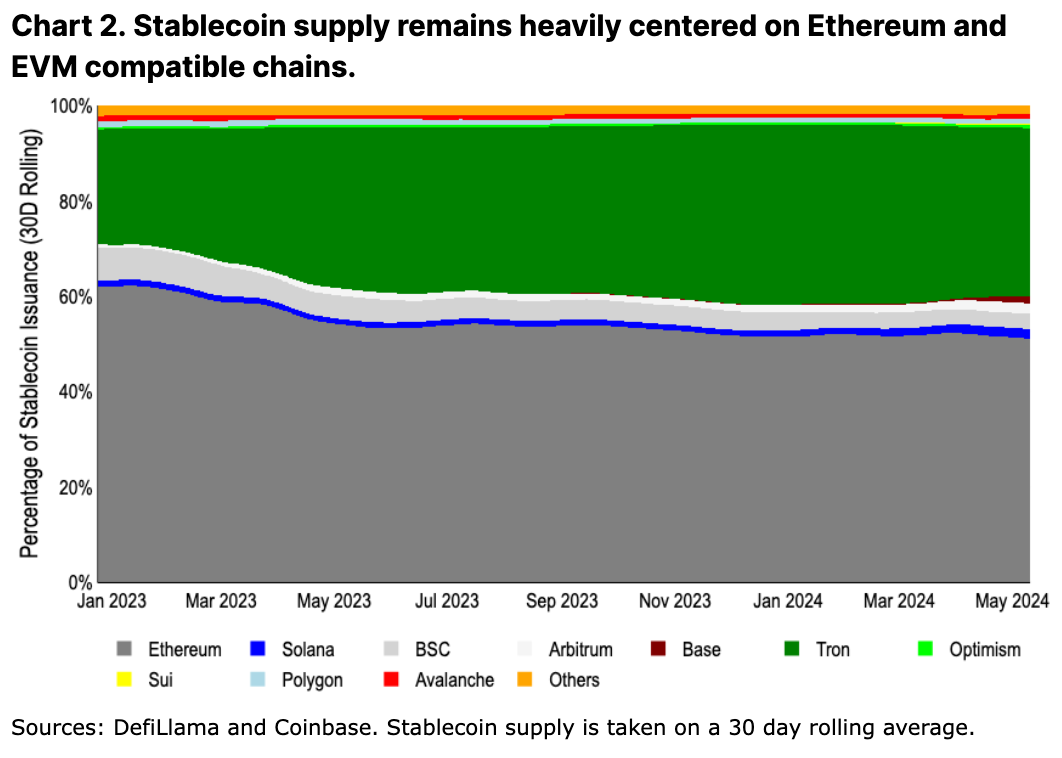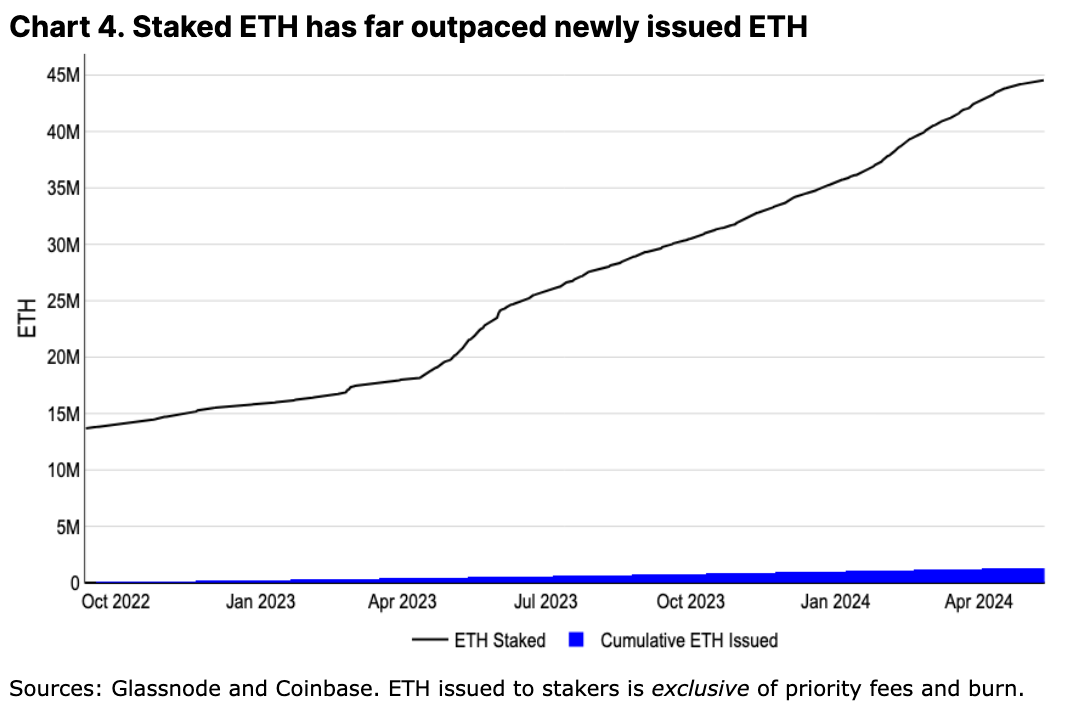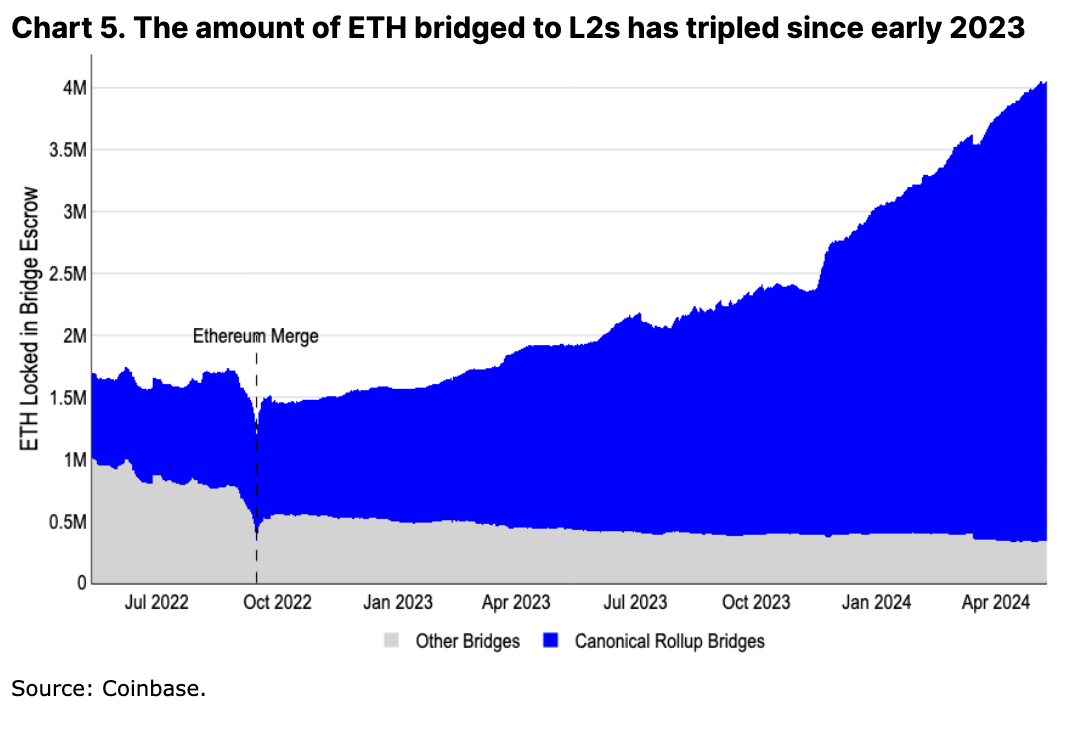The approval of spot bitcoin ETFs in the US has reinforced bitcoin’s store-of-value narrative and its status as a macro asset. On the other hand, open questions about ETH’s fundamental positioning within the crypto sector remain. Competing layer-1s (L1s) like Solana detract from Ethereum’s positioning as the “go-to” network for decentralized app (dApp) deployment. The growth of Ethereum layer-2s (L2s) and reduction in ETH burn also seem to impact the asset’s value accrual mechanisms at a high level.
Despite this, we continue to believe that Ethereum’s long-term positioning remains strong and that it has important advantages that meaningfully distinguish it from other smart contract networks. These include the maturity of Solidity’s developer ecosystem, the proliferation of its EVM platform, the utility of ETH as DeFi collateral, and the decentralization and security of its mainnet. Furthermore, we think that advancements in tokenization are likely to more positively affect ETH relative to other L1s in the near term.
We find that ETH’s ability to capture both store-of-value and technology-token narratives is demonstrated by its historical trading patterns. ETH trades at high levels of correlation to BTC, exhibiting behavior in line with BTC’s store-of-value patterns. At the same time, it also decouples from BTC during periods of prolonged BTC price appreciation like other altcoins, trading like a tech-orientated crypto. We think that ETH will continue to straddle these roles, and has room to outperform in 2H24 despite underperforming YTD.
Addressing the Counter Narratives
ETH has been categorized in a variety of ways, from “ultrasound-money” for its supply burn mechanism to the “internet bond” for its non-inflationary staking yield. With the expansion of L2s and restaking, narratives like “settlement layer asset” or a more esoteric “universal objective work token” have also come to light. But ultimately, we don’t think these characterizations are able to holistically capture ETH’s dynamism on their own. In fact, we believe the increasing complexity around ETH’s use cases has made it difficult to define singular metrics of value capture. Instead, the confluence of these narratives may even appear negative as they can detract from each other – distracting market players from the token’s positive drivers.
Spot ETH ETFs
Spot ETFs have been critically important for BTC by providing regulatory clarity and access to new capital inflows. These ETFs have structurally changed the industry and, in our view, challenged previous cycle patterns whereby capital was rotated from bitcoin to ether to higher beta altcoins. There are barriers between capital allocated to ETFs and capital allocated to centralized exchanges (CEXs), and only the latter has access to the broader universe of crypto assets. The potential approval of a spot ETH ETF removes this impediment for ETH, opening up ETH to the same capital pools that only BTC currently enjoys. In our view, this is perhaps the largest near term overhang for ETH, especially given the current challenging regulatory environment.
While there is uncertainty around a timely approval given the SEC’s apparent silence with issuers, we think that the existence of a US spot ETH ETF remains a question of when, not if. In fact, the primary rationale used to approve the spot BTC ETFs applies equally to spot ETH ETFs. That is, the correlation between the CME futures product and the spot exchange rates is sufficiently high such that “CME’s surveillance can be reasonably expected to detect… misconduct [in the spot market]”. The period of correlation study in the spot BTC approval notice began in March 2021, one month after CME ETH futures launched. We think this evaluation period was deliberately chosen so that a similar reasoning could be applied to ETH markets. Indeed, correlation analysis previously presented by Coinbase and Grayscale suggests that the spot and futures correlation for ETH markets is similar to that for BTC.
Assuming that correlation analysis holds, the remaining possible justifications for a disapproval are likely to stem from a difference between the natures of Ethereum and Bitcoin, in our view. In the past, we’ve covered some of the differences in the size and depth of the ETH vs BTC futures markets that may be a factor for the SEC’s decision. But among the other fundamental differences between ETH and BTC, we think the most relevant for the question of approval is Ethereum’s proof-of-stake (PoS) mechanism.
As there is yet to be clear regulatory guidance on the treatment of asset staking, we think that spot ETH ETFs enabling staking are unlikely to be approved in the near term. The complexities of slashing conditions, differences between validator clients, potentially obscure fee structures from third party staking providers, and unstaking liquidity risks (and exit queue congestion) are meaningfully different from bitcoin. (Notably, there are ETH ETFs in Europe that incorporate staking but in general, exchange-traded products in Europe are distinct from those offered in the US.) That said, this shouldn’t impact the status of unstaked ETH in our view.
We think there is room for surprise to the upside on this decision. Polymarket is pricing in odds of a May 31, 2024 approval at 16%, and the Grayscale Ethereum Trust (ETHE) is trading at a 24% discount to net asset value (NAV). We believe the odds of approval are closer to 30-40%. As crypto begins to take form as an election issue, it’s also less certain in our view that the SEC would be willing to front the political capital necessary to support a denial. Even if the first deadline on May 23, 2024 encounters a rejection, we think there is a high likelihood that litigation could reverse that decision. It is also worth noting that not all spot ETH ETF applications necessarily need to be approved at the same time. In fact, Commissioner Uyeda’s approval statement regarding the spot BTC ETF criticized the disguised “motivation for accelerating the approval of the applications, which is to prevent a first-mover advantage.”
Challenges by Alternative L1s
At an adoption level, the rise of highly scalable integrated chains, in particular Solana, appears to be eating into Ethereum’s market share. High throughput and low fee transactions have moved the epicenter of trading activity away from Ethereum mainnet. Notably, Solana’s ecosystem has grown from encompassing only 2% to now 21% of decentralized exchange (DEX) volume over the past year.
In our view, alternative L1s are also now providing more meaningful differentiation from Ethereum compared to the previous bull cycle. The shift away from the ethereum virtual machine (EVM) and forced redesign of dApps from the ground up has led to a unique user experience (UX) in different ecosystems. Additionally, the integrated/monolithic approach to scaling enables more cross application composability and prevents the problems of lackluster bridging UX and liquidity fragmentation.
While these value propositions are important, we think that extrapolating incentivized activity metrics as a confirmation of success is premature. For example, transaction user counts for some Ethereum L2s dropped more than 80% from their airdrop farming peaks. Meanwhile, Solana’s percentage of total DEX volume grew from 6% to 17% between Jupiter’s airdrop announcement on November 16, 2023 and its first claim date on January 31, 2024. (Jupiter is the leading DEX aggregator on Solana.) Jupiter still has 3 out of 4 airdrop rounds left to complete, so we expect elevated Solana DEX activity to continue for some time. In the interim, assumptions on the ratio of long term activity retention remain speculative.
That said, the proportion of trading activities on the leading Ethereum L2s of Arbitrum, Optimism, and Base now constitute 17% of total DEX volume (in addition to Ethereum’s 33%). This may offer a more appropriate comparison for ETH demand drivers to alternative L1 solutions since ETH is used as the native gas token on all three L2s. MEV and other additional demand drivers for ETH in those networks have also yet to be developed, which presents room for future demand catalysts as well. We think that this is a more equivalent comparison for the adoption of integrated versus modular scaling approaches regarding DEX activity.
Another, more “sticky”, metric for measuring adoption is stablecoin supply. Stablecoin distributions have a slower propensity for change due to bridging and issuance/redemption friction. (See Chart 2. Color schemes and ordering is the same as Chart 1, with Thorchain replaced by Tron.) Measured by stablecoin issuance, activity remains heavily dominated by Ethereum. In our view, this is because the trust assumptions and reliability of many newer chains are still insufficient to support sizable amounts of capital, particularly capital locked in smart contracts. Large capital holders are often indifferent to Ethereum’s higher transaction costs (as a proportion of size), and have a preference for mitigating risks by reducing liquidity downtime and minimizing bridging trust assumptions.
Even so, among the higher throughput chains, stablecoin supply has been growing faster across Ethereum L2s than on Solana. Arbitrum surpassed Solana in stablecoin supply in early 2024 (currently at $3.6B vs $3.2B stablecoins respectively), while Base has grown its stablecoin supply from $160M to $2.4B YTD. While a final verdict is far from clear on the scaling debate, early signs of stablecoin growth may actually favor Ethereum L2s over alternative L1s.

The growing adoption of L2s has led to concerns that they are actually cannibalistic towards ETH – they reduce L1 blockspace demand (and hence transaction fee burns) and may also support non-ETH gas tokens in their ecosystems (further reducing ETH burn). Indeed, ETH’s annualized inflation rate is at its highest rate since the transition to proof-of-stake (PoS) in 2022.
Although inflation is typically understood to be a structurally important component supply for BTC, we do not think this applies to ETH. The entirety of ETH issuance is accrued to stakers, the collective balance of whom has far outpaced the cumulative ETH issuance since the Merge (see Chart 4). This is in direct contrast to proof-of-work (PoW) miner economics in Bitcoin, where the competitive hash rate environment means that miners are required to sell substantial portions of newly issued BTC to finance operations. Whereas miners’ BTC holdings are tracked across cycles for their inevitable selling, the minimal operational costs for staking ETH means that stakers can continue to accrue their positions in perpetuity. In fact, staking has acted as a sink for ETH liquidity – the growth in staked ETH is greater than the rate of ETH issuance (even excluding burns) by a factor of 20.

L2s themselves are also a meaningful demand driver for ETH. More than 3.5M ETH has been bridged into L2 ecosystems, yet another liquidity sink of ETH. Furthermore, even if the ETH bridged to L2s is not directly burned, the surplus of native tokens held to pay for transaction fees by new wallets, their reserve balance, constitutes a soft-lock on an increasing portion of ETH tokens.

Separately, we believe that a core set of activity will perpetually remain on Ethereum mainnet, even as its L2s expand. Restaking activities like EigenLayer or governance actions for major protocols like Aave, Maker, and Uniswap remain firmly rooted in the L1. Users with the highest security concerns (who typically have the largest capital) are also likely to keep funds on the L1 until fully decentralized sequencers and permissionless fraud proofs are deployed and tested – a process which could take years. Even as L2s innovate in different directions, ETH will always remain a component of their treasuries (for paying L1 “rent”) and the native unit of account. We firmly believe that the growth of L2s are positive not only for the Ethereum ecosystem, but also for ETH the asset.
Ethereum’s Edge
Apart from the metric driven narratives commonly covered, we think Ethereum has other advantages that are hard to quantify, but which are important nonetheless. These may not be short term tradable narratives, but instead represent a core set of long term strengths that could sustain its current dominance.
Pristine Collateral and Unit of Account
One of ETH’s most important use cases is its role in DeFi. ETH is able to be leveraged across Ethereum and its L2 ecosystems with minimal counterparty risk. It serves as a form of collateral in money markets like Maker and Aave, and is also the base trading unit for many onchain DEX pairs. An expansion of DeFi on Ethereum and its L2s results in additional liquidity sinks for ETH.
While BTC remains the dominant store-of-value asset more broadly, the usage of wrapped BTC introduces bridging and trust assumptions on Ethereum. We do not think WBTC will displace ETH’s usage in Ethereum-based DeFi – WBTC supply has remained flat for more than a year, more than 40% below previous highs. On the contrary, ETH can benefit from its utility across the diversity of its L2 ecosystems.
Continued Innovation Amidst Decentralization
An often overlooked component of Ethereum’s community is its ability to continue innovating even as it decentralizes. There have been criticisms leveled against Ethereum for its prolonged release timelines and development delays, yet few acknowledge the complexities in weighing the goals and objectives of a diverse set of stakeholders to make technological progress. Developers of more than five execution and four consensus clients need to coordinate in designing, testing, and deploying changes without any downtime to mainnet execution.
In about the same time since Bitcoin’s last major Taproot upgrade in November 2021, Ethereum has enabled dynamic transaction burns (August 2021), transitioned to PoS (September 2022), enabled staking withdrawals (March 2023), and created blob storage for L2 scaling (March 2024) – among a host of other Ethereum Improvement Proposals (EIPs) included in these upgrades. Although many alternative L1s have seemingly been able to develop far more rapidly, their single clients make them more brittle and centralized. The path to decentralization inevitably leads to certain levels of ossification, and it is unclear whether other ecosystems will have the capacity to create a similarly effective development process if and when they begin that process.
Rapid L2 Innovation
That is not to say innovation on Ethereum is slower than other ecosystems. Instead we believe that innovation around execution environments and developer tooling actually outpaces that of its competitors. Ethereum benefits from rapid centralized development of L2s, all of which pay settlement fees to the L1 in ETH. The ability to create varying platforms with different execution environments (e.g. Web Assembly, Move, or the Solana Virtual Machine) or other features like privacy or boosted staking rewards, means that the slower development timelines of the L1 does not hold ETH back from gaining adoption in more technologically comprehensive use cases.
At the same time, the efforts of the Ethereum community to define different trust assumptions and definitions around sidechains, validiums, rollups, etc. gives rise to greater transparency in the space. Similar efforts (like L2Beat) are not yet apparent in the Bitcoin L2 ecosystem, for example, where its L2 trust assumptions vary widely and are often not well communicated or understood by the broader community.
EVM Proliferation
The innovation around new execution environments does not mean that Solidity and the EVM will be obsolete in the near future. On the contrary, the EVM has widely proliferated to other chains. Research in Ethereum’s L2s are being adopted by many Bitcoin L2s for example. A large portion of Solidity’s shortcomings (e.g. the ease of including a reentrancy vulnerability) now have static tool checkers to prevent basic exploits. Additionally, the popularity of the language has created a well-established auditing sector, volumes of open-source code samples, and detailed guides for best practices. All of these are important for building a large developer talent pool.
Although EVM usage does not directly lead to ETH demand, changes to the EVM are rooted in Ethereum’s development processes. These changes are subsequently adopted by other chains to retain EVM-compatibility. In our view, core innovations to the EVM are likely to remain rooted in Ethereum – or to be very quickly co-opted by an L2 – which would center developer mindshare and thus new protocols within the Ethereum ecosystem.
Tokenization and Lindy Effects
The push for tokenization projects and increasing regulatory global clarity in the space are also likely to benefit Ethereum foremost (among public blockchains) in our view. Financial products are often focused on technological risk mitigation over optimizations and feature richness, and Ethereum has the benefit of being the longest running smart contract platform. We believe that modestly higher transaction fees (dollars instead of cents) and longer confirmation times (seconds instead of milliseconds) are secondary concerns for many large tokenization projects.
Additionally, for more traditional firms looking to expand operations onchain, hiring sufficient amounts of developer talent becomes a critical factor. Here, Solidity becomes the obvious choice as it constitutes the largest subset of smart contract developers, which hearkens to the earlier point on EVM proliferation above. Blackrock’s BUIDL fund on Ethereum and JPM’s proposed and ERC-20 compatible Onyx Digital Assets Fungible Asset Contract (ODA-FACT) token standard are early signs of the importance of this hiring pool.
Structural Supply Mechanics
The variations in active ETH supply are meaningfully different from that of BTC. The 3 month circulating supply of ETH has not meaningfully increased despite the runup in price since 4Q23. In contrast, we observed a nearly 75% increase in active BTC supply over the same timeframe. Instead of long term ETH holders contributing to an increase in circulating supply (like was seen in the 2021/22 cycle when Ethereum still operated under PoW), an ever-growing portion of the ETH supply is staked. This reaffirms our view that staking is a critical liquidity sink for ETH and minimizes structural sell-side pressure of the asset.
An Evolving Trading Regime
ETH has historically traded more in line with BTC than any other altcoin. At the same time, it has also decoupled from BTC during bull market peaks or idiosyncratic ecosystem events – a similar pattern observed in other altcoins, albeit to a smaller extent (see Chart 7). We believe this trading behavior is reflective of the market’s relative valuation of ETH as both a store-of-value token and as a technological utility token.
Throughout 2023, the change in ETH’s correlation to BTC was inversely related to changes in the BTC price (see Chart 8). That is, as BTC appreciated in value, ETH’s correlation with it lowered and vice versa. In fact, the changes in BTC price appeared to be a leading indicator for changes in ETH’s correlation. We think that is an indicator of BTC price-led market exuberance in the altcoins, which in turn boosts their speculative performance (i.e. altcoins trade differently in bullish markets, but consolidate against BTC performance in bearish ones).
This trend has ceased somewhat following spot US BTC ETF approvals, however. In our view, this highlights the structural impact of ETF-based inflows, where an entirely new capital base solely has access to BTC. The new market of registered investment advisors (RIAs), wealth managers, and wirehouses, are likely to view BTC quite differently in a portfolio relative to many crypto natives or retail traders. Whereas BTC is the least volatile asset in a pure crypto portfolio, it is often seen as a small diversification asset in more traditional fixed income and equity portfolios. We think this shift in BTC’s utility has had an impact on its trading patterns relative to ETH, and that ETH could see a similar shift (and realignment of trading patterns) in the event of spot US ETH ETFs.
Conclusion
We think that ETH may yet have the potential to surprise to the upside in the coming months. ETH does not appear to have major sources of supply side overhangs such as token unlocks or miner sell pressure. To the contrary, both staking and L2 growth have proven to be meaningful and growing sinks of ETH liquidity. ETH’s position as the center of DeFi is also unlikely to be displaced in our view due to the widespread adoption of the EVM and its L2 innovations.
That said, the importance of potential spot US ETH ETFs cannot be understated. We think the market may be underestimating the timing and odds of a potential approval, which leaves room for surprises to the upside. In the interim, we believe the structural demand drivers for ETH as well as the technological innovations within its ecosystem will enable it to continue straddling across multiple narratives.











